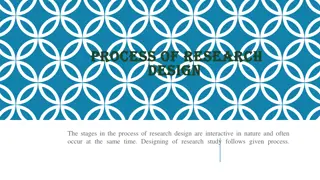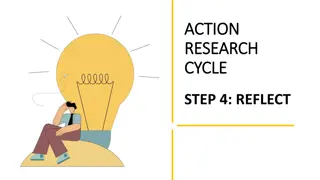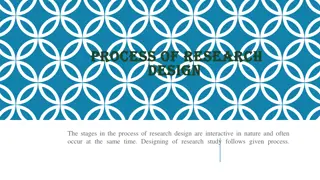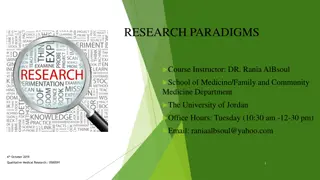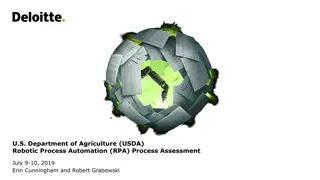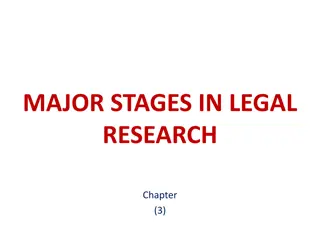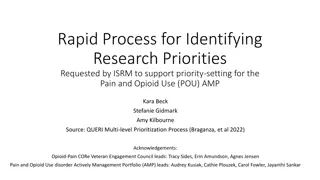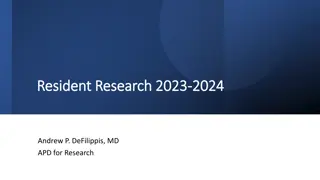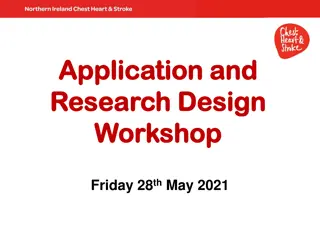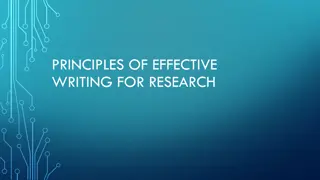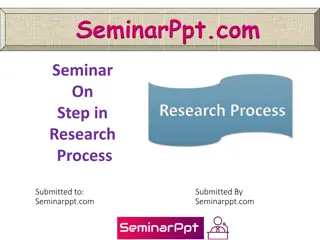
Effective Research Process Steps for Generating Valuable Knowledge
"Learn about the systematic steps in the research process, from identifying the problem to creating hypotheses and designing research, to generate valuable knowledge. Explore key steps like problem identification, literature evaluation, hypothesis formulation, and research design."
Download Presentation

Please find below an Image/Link to download the presentation.
The content on the website is provided AS IS for your information and personal use only. It may not be sold, licensed, or shared on other websites without obtaining consent from the author. If you encounter any issues during the download, it is possible that the publisher has removed the file from their server.
You are allowed to download the files provided on this website for personal or commercial use, subject to the condition that they are used lawfully. All files are the property of their respective owners.
The content on the website is provided AS IS for your information and personal use only. It may not be sold, licensed, or shared on other websites without obtaining consent from the author.
E N D
Presentation Transcript
Research Process Steps The research process consists of systematic procedures that a researcher must go through in order to generate knowledge that will be considered valuable by the project and focus on the relevant topic. To conduct effective research, you must understand the research process steps and follow them. Here are a few steps in the research process to make it easier foryou: a series of
Step 1: Identify the Problem Finding an issue or formulating a research question is the first step. A well-defined research problem will guide the researcher through all stages of the research process, from setting technique. There are a number of approaches to get insight into a topic and gain a better understanding of it. Such as: A preliminary survey Case studies Interviews with a small groupof people Observational survey objectives to choosing a
Step 2: Evaluate the Literature A thorough examination of the relevant studies is essential to the research process. It enables the researcher to identify the precise aspects of the problem. Once a problem has been found, the investigator or researcher needs to find out more about it. This stage gives problem-zone background. It teaches the investigator about previous research, how they were conducted, and its conclusions. The researcher can build consistency between his work and others through a literature review. Such a review exposes the researcher to a more significant body of knowledge and helps him follow the research process efficiently.
Step 3: Create Hypothesis Formulating an original hypothesis is the next logical step after narrowing down the research topic and defining it. A belief solves logical relationships between variables. In order to establish a hypothesis, a researcher must have a certain amount of expertise in the field. It is important for researchers to keep in mind while formulating a hypothesis that it must be based on the research topic. Researchers are able to concentrate their efforts and stay committed to their objectives when theydevelop theories toguide theirwork.
Step 4: The Research Design Research design is the plan for achieving objectives and answering research questions. It outlines how to get the relevant information. Its goal is to design research to test hypotheses, address the research questions, and provide decision-making insights. The research design aims to minimize the time, money, and effort required to acquire meaningful evidence. This plan fits into four categories: Exploration and Surveys Experiment Data Analysis Observation
Step 5: Describe Population Research projects usually look at a specific group of people, facilities, or how technology is used in the business. In research, the term population refers to this study group. The research topic and purpose help determine the studygroup. Suppose a researcher wishes to investigate a certain group of people in the community. In that case, the research could target a specific age group, males or females, a geographic location, or an ethnic group. A final step in a study s design is to specify its sample or populationso that the results may begeneralized.
Step 6: Data Collection Data collection is important in obtaining the knowledge or information required to answer the research issue. Every research collected data, either from the literature or the people being studied. Data must be collected from the two categories of researchers. These sources may provide primarydata. Experiment Questionnaire Observation Interview Secondary datacategoriesare: Literaturesurvey Official, unofficial reports An approach based on library resources
Step 7: Data Analysis During research design, the researcher plans data analysis. After collecting data, the researcher analyzes it. The data is examined based on the approach in this step. The research findings are reviewed and reported. Data analysis involves a number of closely related stages, such as setting up categories, applying these categories to raw data through coding and tabulation, and then drawing statistical conclusions. The researcher can examine the acquired data using avarietyof statistical methods.
Step 8: The Report-writing After completing these steps, the researcher must prepare a report detailing his findings. The report must be carefully composed with the following in mind: The Layout: On the first page, the title, date, acknowledgments, and preface should be on the report. A table of contents should be followed by a listof tables, graphs, and charts if any. Introduction: It should state the research s purpose and methods. This section should include the study s scope and limits. Summary of Findings: A non-technical summary of findings and recommendations will follow the introduction. The findings should be summarized if they re lengthy. Principal Report: The main body of the report should make sense and be broken up intosections thatareeasy to understand. Conclusion: The researcher should restate his findings at the end of the main text. It s the final result.

